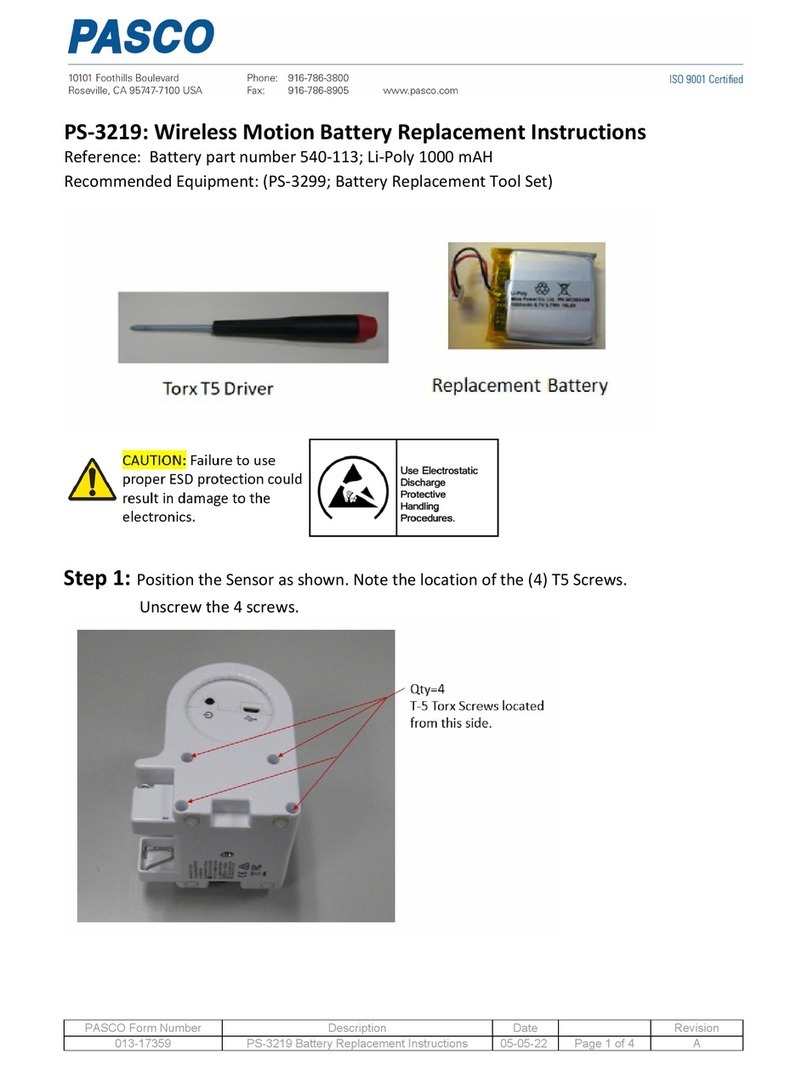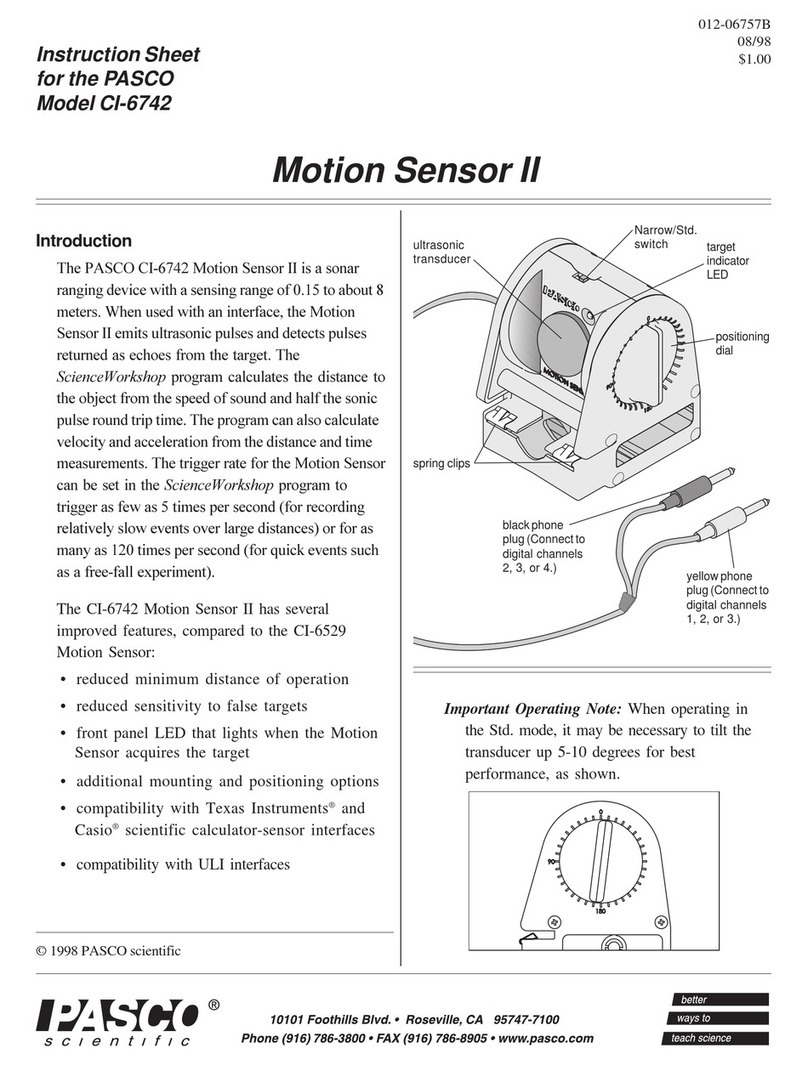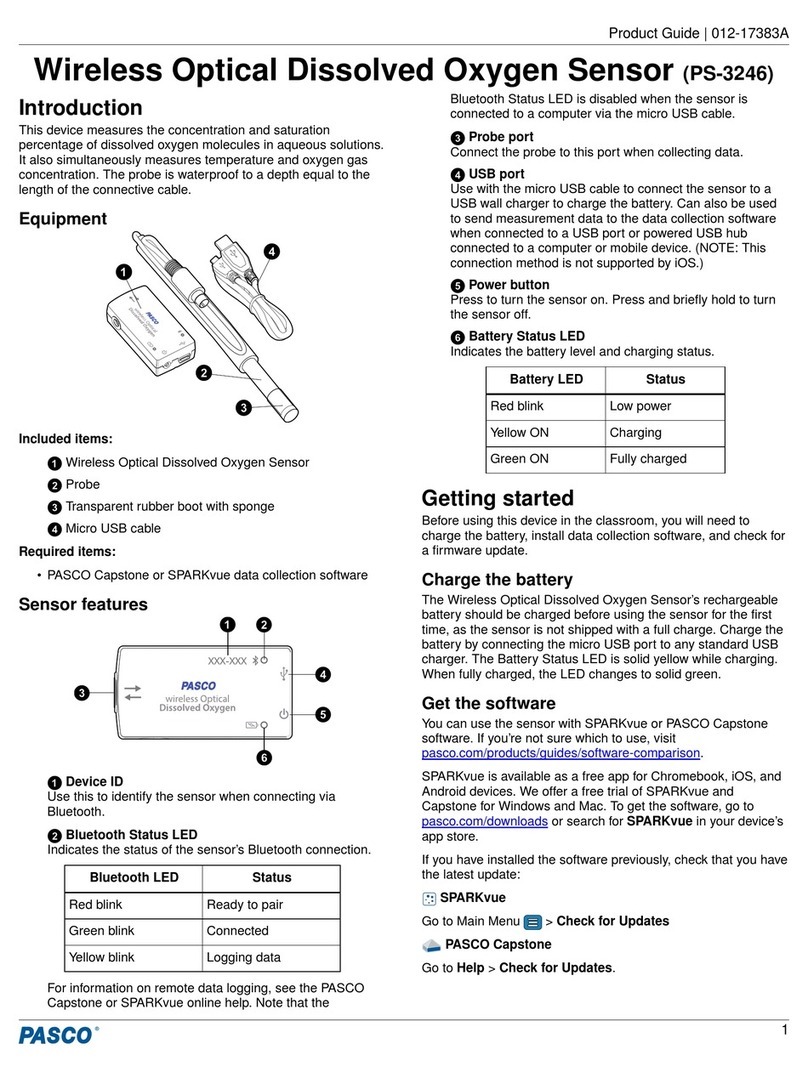
Using the sensor
The sensor is designed to work with PASCO data collection
software (PASCO Capstone and SPARKvue) to measure
magnetic field strength.
In the software, start data collection to begin recording magnetic
field strength along all three axes in units of gauss (G). Position
the sensing elements, marked by the dots on the end of the
probe, at the location to be measured and orient the sensor with
the field lines. Magnetic field lines entering the dots on the probe
result in a positive reading.
Charge the battery
Charge the battery by connecting the micro USB port to any
standard USB charger. The Battery Status LED is solid yellow
while charging. When fully charged, the LED changes to solid
green.
Get the software
You can use the sensor with SPARKvue or PASCO Capstone
software. If you’re not sure which to use, visit
pasco.com/products/guides/software-comparison.
SPARKvue is available as a free app for Chromebook, iOS, and
Android devices. We offer a free trial of SPARKvue and
Capstone for Windows and Mac. To get the software, go to
pasco.com/downloads or search for SPARKvue in your device’s
app store.
If you have installed the software previously, check that you have
the latest update:
SPARKvue
Go to Main Menu > Check for Updates
PASCO Capstone
Go to Help > Check for Updates.
Check for a firmware update
SPARKvue
1. Press the power button until the lights turn on.
2. Open SPARKvue.
3. Select Sensor Data on the Welcome Screen.
4. Select the sensor that matches its device ID. A notification
appears if a firmware update is available. Click Yes to
update the firmware.
5. Close SPARKvue when the update is complete.
PASCO Capstone
1. Press and hold the power button until the lights turn on.
2. Open PASCO Capstone.
3. Click Hardware Setup.
4. Select the sensor that matches its device ID. A notification
appears if a firmware update is available. Click Yes to
update the firmware.
5. Close Capstone when the update is complete.
Set up the software
SPARKvue
Connecting the sensor to a tablet or computer via
Bluetooth:
1. Turn on the Wireless Magnetic Field Sensor. Check to
make sure the Bluetooth Status LED is blinking red.
2. Open SPARKvue, then click Sensor Data.
3. From the list of available wireless devices on the left, select
the device which matches the device ID printed on your
Magnetic Field Sensor.
Connecting the sensor to a computer via micro USB cable:
1. Turn on the Wireless Magnetic Field Sensor.
2. Open SPARKvue, then click Sensor Data.
3. Connect the provided micro USB cable from the micro USB
port on the sensor to a USB port or powered USB hub
connected to the computer. The sensor should
automatically connect to SPARKvue.
Collecting data using SPARKvue:
1. Select the measurements you intend to record from the
Select Measurements for Templates menu by clicking the
check box next to the relevant measurements' names.
2. Click Graph in the Templates section to open the
Experiment Screen. The graph’s axes will auto-populate
with the selected measurements.
3. Click Start to begin recording data.
Switching range in SPARKvue:
SPARKvue uses the ±50 G sensing element by default. Follow
these steps to switch to the ±1300 G sensing element if desired.
1. From the Experiment Screen, click the Live Data Bar for
one of the sensor measurements and select Configure
Sensor.
2. From the Edit Sensor Properties menu, click the box next
to Range and select ±1300G.
3. Click OK to return to the Experiment Screen.
PASCO Capstone
Connecting the sensor to a computer via Bluetooth:
1. Turn on the Wireless Magnetic Field Sensor. Check to
make sure the Bluetooth Status LED is blinking red.
2. Open Capstone, then click Hardware Setup in the
Tools palette.
3. From the list of Available Wireless Devices, click the
device which matches the device ID printed on your
Magnetic Field Sensor.
Wireless 3-Axis Magnetic Field Sensor | PS-3221
2

























